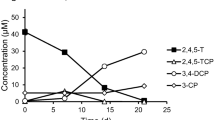Abstract
Anaerobic tetrachloroethene(C2Cl4)-dechlorinating bacteria were enriched in slurries from chloroethene-contaminated soil. With methanol as electron donor, C2Cl4 and trichloroethene (C2HCl3) were reductively dechlorinated to cis-1,2-dichloroethene (cis-C2H2Cl2), whereas, with l-lactate or formate, complete dechlorination of C2Cl4 via C2HCl3, cis-C2H2Cl2 and chloroethene (C2H3Cl) to ethene was obtained. In oxic soil slurries with methane as a substrate, complete co-metabolic degradation of cis-C2H2Cl2 was obtained, whereas C2HCl3 was partially degraded. With toluene or phenol both of the above were readily co-metabolized. Complete degradation of C2Cl4 was obtained in sequentially coupled anoxic and oxic chemostats, which were inoculated with the slurry enrichments. Apparent steady states were obtained at various dilution rates (0.02–0.4 h−1) and influent C2Cl4-concentrations (100–1000 μM). In anoxic chemostats with a mixture␣of␣formate and glucose as the carbon and electron source, C2Cl4 was transformed at high rates (above␣140 μmol l−1 h−1, corresponding to 145 nmol Cl− min−1 mg protein−1) into cis-C2H2Cl2 and C2H3Cl. Reductive dechlorination was not affected by addition of 5 mM sulphate, but strongly inhibited after addition of 5 mM nitrate. Our results (high specific dechlorination rates and loss of dechlorination capacity in the absence of C2Cl4) suggest that C2Cl4-dechlorination in the anoxic chemostat was catalysed by specialized dechlorinating bacteria. The partially dechlorinated intermediates, cis-C2H2Cl2 and C2H3Cl, were further degraded by aerobic phenol-metabolizing bacteria. The maximum capacity for chloroethene (the sum of tri-, di- and monochloro derivatives removed) degradation in the oxic chemostat was 95 μmol l−1 h−1 (20 nmol min−1 mg protein−1), and that of the combined anoxic → oxic reactor system was 43.4 μmol l−1 h−1. This is significantly higher than reported thus far.
Similar content being viewed by others
Author information
Authors and Affiliations
Additional information
Received: 17 April 1997 / Received revision: 6 June 1997 / Accepted: 7 June 1997
Rights and permissions
About this article
Cite this article
Gerritse, J., Kloetstra, G., Borger, A. et al. Complete degradation of tetrachloroethene in coupled anoxic and oxic chemostats. Appl Microbiol Biotechnol 48, 553–562 (1997). https://doi.org/10.1007/s002530051096
Issue Date:
DOI: https://doi.org/10.1007/s002530051096




